Identifying Trade-Offs and Synergies of Production–Living–Ecological Functions and Their Drivers: The Case of Yangtze River Urban Agglomerations in China
Abstract
:1. Introduction
2. Materials and Methods
2.1. Study Area
2.2. Data Sources
2.3. Methods
2.3.1. An Indicator System for Assessing PLE Functions
2.3.2. PLE Function Evaluation
2.3.3. Trade-Offs and Synergies among PLE Functions
2.3.4. Analysis of the Driving Mechanism
- (1)
- Selection of driving factors
- (2)
- Geographically Weighted Regression
3. Results
3.1. Spatiotemporal Characteristics of PLE Functions
3.2. Spatial Patterns of Trade-Offs and Synergies among PLE Functions
3.2.1. Temporal Change of Trade-Offs and Synergies
3.2.2. Spatial Distribution Characteristics of Trade-Offs and Synergies
3.3. Driving Forces of the Trade-Offs and Synergies in PLE Functions
4. Discussion
4.1. Spatiotemporal Changes of Trade-Offs and Synergies among PLE Functions
4.2. Identifying Driving Factors Affecting Trade-Offs and Synergies among PLE Functions
4.3. Policy Implications
4.4. Limitations and Future Research
5. Conclusions
Author Contributions
Funding
Data Availability Statement
Conflicts of Interest
References
- Liu, Y.S. Introduction to land use and rural sustainability in China. Land Use Policy 2018, 74, 1–4. [Google Scholar] [CrossRef]
- Yang, F.S.; Yang, X.M.; Wang, Z.H.; Sun, Y.J.; Zhang, Y.H.; Xing, H.Q.; Wang, Q. Spatiotemporal Evolution of Production-Living-Ecological Land and Its Eco-Environmental Response in China’s Coastal Zone. Remote Sens. 2023, 15, 3039. [Google Scholar] [CrossRef]
- Wang, J.Y.; Sun, Q.; Zou, L.L. Spatial-temporal evolution and driving mechanism of rural production-living-ecological space in Pingtan islands, China. Habitat Int. 2023, 137, 102833. [Google Scholar] [CrossRef]
- Zhang, X.; Xu, Z. Functional Coupling Degree and Human Activity Intensity of Production–Living–Ecological Space in Underdeveloped Regions in China: Case Study of Guizhou Province. Land 2021, 10, 56. [Google Scholar] [CrossRef]
- Liu, C.; Xu, Y.Q.; Huang, A.; Li, Y.X.; Wang, H.; Lu, L.H.; Sun, P.L.; Zheng, W. Spatial identification of land use multifunctionality at grid scale in farming-pastoral area: A case study of Zhangjiakou City, China. Habitat Int. 2018, 76, 48–61. [Google Scholar] [CrossRef]
- Li, L.; Ma, S.J.; Zheng, Y.L.; Xiao, X.Y. Integrated regional development: Comparison of urban agglomeration policies in China. Land Use Policy 2022, 114, 105939. [Google Scholar] [CrossRef]
- Lin, S.J.; Li, C.; Li, Y.B.; Chen, L.D. Exploring Integrative Development of Urban Agglomeration from the Perspective of Urban Symbiosis and Production-Living-Ecological Function. Land 2024, 13, 258. [Google Scholar] [CrossRef]
- Zhang, R.; Chen, S.; Gao, L.; Hu, J.J. Spatiotemporal evolution and impact mechanism of ecological vulnerability in the Guangdong-Hong Kong-Macao Greater Bay Area. Ecol. Indic. 2023, 157, 111214. [Google Scholar] [CrossRef]
- Liu, J.M.; Pei, X.T.; Zhu, W.Y.; Jiao, J.Z. Understanding the intricate tradeoffs among ecosystem services in the Beijing-Tianjin-Hebei urban agglomeration across spatiotemporal features. Sci. Total Environ. 2023, 898, 165453. [Google Scholar] [CrossRef]
- Gao, Y.L.; Li, H.B.; Song, Y. Interaction Relationship between Urbanization and Land Use Multifunctionality: Evidence from Han River Basin, China. Land 2021, 10, 938. [Google Scholar] [CrossRef]
- Xiong, S.W.; Yang, F.; Zhang, J.Y.; Tang, Y.L. An integrated model chain for diagnosing and predicting conflicts between production-living-ecological space in lake network regions: A case of the Dongting Lake region, China. Ecol. Indic. 2024, 166, 112237. [Google Scholar] [CrossRef]
- Yin, Y.T.; Xi, F.R. Simulation of the evolution track of future Production-Living-Ecological Space under the framework of comprehensive assessment of climate change: A case study of Heilongjiang Province, China. Environ. Technol. Innov. 2023, 30, 103129. [Google Scholar] [CrossRef]
- Zhang, Z.; Li, J.M. Spatial suitability and multi-scenarios for land use: Simulation and policy insights from the production-living-ecological perspective. Land Use Policy 2022, 119, 106219. [Google Scholar] [CrossRef]
- Wang, Y.F. Spatial-temporal evolution of “Production-Living-Ecologica” function and layout optimization Strategy in China: A case study of Liaoning Province, China. Environ. Sci. Pollut. Res. 2023, 30, 10683–10696. [Google Scholar] [CrossRef]
- Ouyang, X.; Xu, J.; Li, J.Y.; Wei, X.; Li, Y.H. Land space optimization of urban-agriculture-ecological functions in the Changsha-Zhuzhou-Xiangtan Urban Agglomeration, China. Land Use Policy 2022, 117, 106112. [Google Scholar] [CrossRef]
- Zou, L.L.; Liu, Y.S.; Yang, J.X.; Yang, S.F.; Wang, Y.S.; Zhi, C.; Hu, X.D. Quantitative identification and spatial analysis of land use ecological-production-living functions in rural areas on China’s southeast coast. Habitat Int. 2020, 100, 102182. [Google Scholar] [CrossRef]
- Zhou, D.; Xu, J.C.; Lin, Z.L. Conflict or coordination? Assessing land use multi-functionalization using production-living-ecology analysis. Sci. Total Environ. 2017, 577, 136–147. [Google Scholar] [CrossRef] [PubMed]
- Xi, F.R.; Wang, R.P.; Shi, J.S.; Zhang, J.D.; Yu, Y.; Wang, N.; Wang, Z.Y. Spatio-Temporal Pattern and Conflict Identification of Production-Living-Ecological Space in the Yellow River Basin. Land 2022, 11, 744. [Google Scholar] [CrossRef]
- Li, C.X.; Wu, J.Y. Land use transformation and eco-environmental effects based on production-living-ecological spatial synergy: Evidence from Shaanxi Province, China. Environ. Sci. Pollut. Res. 2022, 29, 41492–41504. [Google Scholar] [CrossRef]
- Wang, A.Y.; Liao, X.Y.; Tong, Z.J.; Du, W.L.; Zhang, J.Q.; Liu, X.P.; Liu, M.S. Spatial-temporal dynamic evaluation of the ecosystem service value from the perspective of “production-living-ecological” spaces: A case study in Dongliao River Basin, China. J. Clean. Prod. 2022, 333, 130218. [Google Scholar] [CrossRef]
- Zhang, H.; Wu, S.H.; Dang, Y.X.; Liu, D.; Qiu, L.F. Multi-functional identification of social-ecological landscape in ecologically fragile areas under the background of regional transformation development. Environ. Sci. Pollut. Res. 2023, 30, 19062–19082. [Google Scholar] [CrossRef] [PubMed]
- Yang, Y.Y.; Bao, W.K.; Liu, Y.S. Coupling coordination analysis of rural production-living-ecological space in the Beijing-Tianjin-Hebei region. Ecol. Indic. 2020, 117, 106512. [Google Scholar] [CrossRef]
- Liu, C.; Xu, Y.Q.; Lu, X.H.; Han, J. Trade-offs and driving forces of land use functions in ecologically fragile areas of northern Hebei Province: Spatiotemporal analysis. Land Use Policy 2021, 104, 105387. [Google Scholar] [CrossRef]
- Liu, Y.C.; Jing, Y.D.; Han, S.M. Ecological function zoning of Nansi Lake Basin in China based on ecosystem service bundles. Environ. Sci. Pollut. Res. 2023, 30, 77343–77357. [Google Scholar] [CrossRef]
- Wang, Z.J.; Yang, H.; Hu, Y.M.; Peng, Y.P.; Liu, L.; Su, S.Q.; Wang, W.; Wu, J.L. Multifunctional trade-off/synergy relationship of cultivated land in Guangdong: A long time series analysis from 2010 to 2030. Ecol. Indic. 2023, 154, 110700. [Google Scholar] [CrossRef]
- Gao, Y.X.; Wang, Z.Q.; Zhang, L.G.; Chai, J. Spatial identification and multilevel zoning of land use functions improve sustainable regional management: A case study of the Yangtze River Economic Belt, China. Environ. Sci. Pollut. Res. 2023, 30, 27782–27798. [Google Scholar] [CrossRef]
- Yang, Y.; Li, M.W.; Feng, X.M.; Yan, H.M.; Su, M.R.; Wu, M.W. Spatiotemporal variation of essential ecosystem services and their trade-off/synergy along with rapid urbanization in the Lower Pearl River Basin, China. Ecol. Indic. 2021, 133, 108439. [Google Scholar] [CrossRef]
- Lyu, Y.F.; Wang, M.J.; Zou, Y.N.; Wu, C.F. Mapping trade-offs among urban fringe land use functions to accurately support spatial planning. Sci. Total Environ. 2022, 802, 149915. [Google Scholar] [CrossRef]
- Zhang, J.; Li, S.N.; Lin, N.F.; Lin, Y.; Yuan, S.F.; Zhang, L.; Zhu, J.X.; Wang, K.; Gan, M.Y.; Zhu, C.M. Spatial identification and trade-off analysis of land use functions improve spatial zoning management in rapid urbanized areas, China. Land Use Policy 2022, 116, 106058. [Google Scholar] [CrossRef]
- Fan, Y.T.; Gan, L.; Hong, C.Q.; Jessup, L.H.; Jin, X.B.; Pijanowski, B.C.; Sun, Y.; Lv, L.G. Spatial identification and determinants of trade-offs among multiple land use functions in Jiangsu Province, China. Sci. Total Environ. 2021, 772, 145022. [Google Scholar] [CrossRef]
- Jiang, X.T.; Zhai, S.Y.; Liu, H.; Chen, J.; Zhu, Y.Y.; Wang, Z. Multi-scenario simulation of production-living-ecological space and ecological effects based on shared socioeconomic pathways in Zhengzhou, China. Ecol. Indic. 2022, 137, 108750. [Google Scholar] [CrossRef]
- Zhang, Y.N.; Long, H.L.; Tu, S.S.; Ge, D.Z.; Ma, L.; Wang, L.Z. Spatial identification of land use functions and their tradeoffs/synergies in China: Implications for sustainable land management. Ecol. Indic. 2019, 107, 105550. [Google Scholar] [CrossRef]
- Li, S.N.; Zhao, X.Q.; Pu, J.W.; Miao, P.P.; Wang, Q.; Tan, K. Optimize and control territorial spatial functional areas to improve the ecological stability and total environment in karst areas of Southwest China. Land Use Policy 2021, 100, 104940. [Google Scholar] [CrossRef]
- Cao, Y.; Li, G.Y.; Tian, Y.H.; Fang, X.Q.; Li, Y.; Tan, Y.Z. Linking ecosystem services trade-offs, bundles and hotspot identification with cropland management in the coastal Hangzhou Bay area of China. Land Use Policy 2020, 97, 104689. [Google Scholar] [CrossRef]
- Zhu, J.; Shang, Z.; Long, C.; Lu, S. Functional Measurements, Pattern Evolution, and Coupling Characteristics of “Production-Living-Ecological Space” in the Yangtze Delta Region. Sustainability 2023, 24, 16712. [Google Scholar] [CrossRef]
- Zhao, Y.; Cheng, J.; Zhu, Y.; Zhao, Y. Spatiotemporal evolution and regional differences in the production-living-ecological space of the urban agglomeration in the middle reaches of the Yangtze River. Int. J. Environ. Res. Public Health 2021, 18, 12497. [Google Scholar] [CrossRef]
- Chen, W.X. A multi-scale assessment of ecosystem health based on the Pressure-State-Response framework: A case in the Middle Reaches of the Yangtze River Urban Agglomerations, China. Environ. Sci. Pollut. Res. 2022, 29, 29202–29219. [Google Scholar] [CrossRef]
- Chen, W.X.; Chi, G.Q.; Li, J.F. The spatial aspect of ecosystem services balance and its determinants. Land Use Policy 2020, 90, 104263. [Google Scholar] [CrossRef]
- Wang, D.; Jiang, D.; Fu, J.Y.; Lin, G.; Zhang, J.L. Comprehensive Assessment of Production-Living-Ecological Space Based on the Coupling Coordination Degree Model. Sustainability 2020, 12, 2009. [Google Scholar] [CrossRef]
- Govind, A.; Chen, J.M.; Margolis, H.; Ju, W.M.; Sonnentag, O.; Giasson, M.A. A spatially explicit hydro-ecological modeling framework (BEPS-TerrainLab V2.0): Model description and test in a boreal ecosystem in Eastern North America. J. Hydrol. 2009, 367, 200–216. [Google Scholar] [CrossRef]
- Chen, Y.; Zhu, M.K. Spatiotemporal Evolution and Driving Mechanism of “Production-Living-Ecology” Functions in China: A Case of Both Sides of Hu Line. Int. J. Environ. Res. Public Health 2022, 19, 3488. [Google Scholar] [CrossRef] [PubMed]
- Fan, Y.T.; Jin, X.B.; Gan, L.; Jessup, L.H.; Pijanowski, B.C.; Lin, J.H.; Yang, Q.K.; Lyu, L. Dynamics of spatial associations among multiple land use functions and their driving mechanisms: A case study of the Yangtze River Delta region, China. Environ. Impact Assess. Rev. 2022, 97, 106858. [Google Scholar] [CrossRef]
- Zhu, C.M.; Dong, B.Y.; Li, S.N.; Lin, Y.; Shahtahmassebi, A.; You, S.X.; Zhang, J.; Gan, M.Y.; Yang, L.X.; Wang, K. Identifying the trade-offs and synergies among land use functions and their influencing factors from a geospatial perspective: A case study in Hangzhou, China. J. Clean. Prod. 2021, 314, 128026. [Google Scholar] [CrossRef]
- Deng, Y.; Yang, R. Influence mechanism of production-living-ecological space changes in the urbanization process of Guangdong Province, China. Land 2021, 10, 1357. [Google Scholar] [CrossRef]
- Pan, Z.Z.; He, J.H.; Liu, D.F.; Wang, J.W.; Guo, X.A. Ecosystem health assessment based on ecological integrity and ecosystem services demand in the Middle Reaches of the Yangtze River Economic Belt, China. Sci. Total Environ. 2021, 774, 144837. [Google Scholar] [CrossRef]
- Kanter, D.R.; Musumba, M.; Wood, S.L.R.; Palm, C.; Antle, J.; Balvanera, P.; Dale, V.H.; Havlik, P.; Kline, K.L.; Scholes, R.J.; et al. Evaluating agricultural trade-offs in the age of sustainable development. Agric. Syst. 2018, 163, 73–88. [Google Scholar] [CrossRef]
- Lu, Q.; Sun, J.; Xiao, Y.; Zhu, S.; Zhu, G.; Liu, J.; Li, X.; Liu, H. The progression traits of spatial conflicts within the production–living–ecological space among varying geomorphological types of mountain–basin areas in karst regions, China. Ecol. Indic. 2024, 166, 112324. [Google Scholar] [CrossRef]
- Zhang, S.; Zhao, K.; Ji, S.; Guo, Y.; Wu, F.; Liu, J.; Xie, F. Evolution characteristics, eco-environmental response and influencing factors of production-living-ecological space in the Qinghai–Tibet Plateau. Land 2022, 11, 1020. [Google Scholar] [CrossRef]
- Fang, L.L.; Wang, L.C.; Chen, W.X.; Sun, J.; Cao, Q.; Wang, S.Q.; Wang, L.Z. Identifying the impacts of natural and human factors on ecosystem service in the Yangtze and Yellow River Basins. J. Clean. Prod. 2021, 314, 127995. [Google Scholar] [CrossRef]
- Zhang, Z.Y.; Liu, Y.F.; Wang, Y.H.; Liu, Y.L.; Zhang, Y.; Zhang, Y. What factors affect the synergy and tradeoff between ecosystem services, and how, from a geospatial perspective? J. Clean. Prod. 2020, 257, 120454. [Google Scholar] [CrossRef]
- Mengist, W.; Soromessa, T.; Feyisa, G.L. Landscape change effects on habitat quality in a forest biosphere reserve: Implications for the conservation of native habitats. J. Clean. Prod. 2021, 329, 129778. [Google Scholar] [CrossRef]
- Liu, J.; Jin, X.B.; Xu, W.Y.; Fan, Y.T.; Ren, J.; Zhang, X.L.; Zhou, Y.K. Spatial coupling differentiation and development zoning trade-off of land space utilization efficiency in eastern China. Land Use Policy 2019, 85, 310–327. [Google Scholar] [CrossRef]
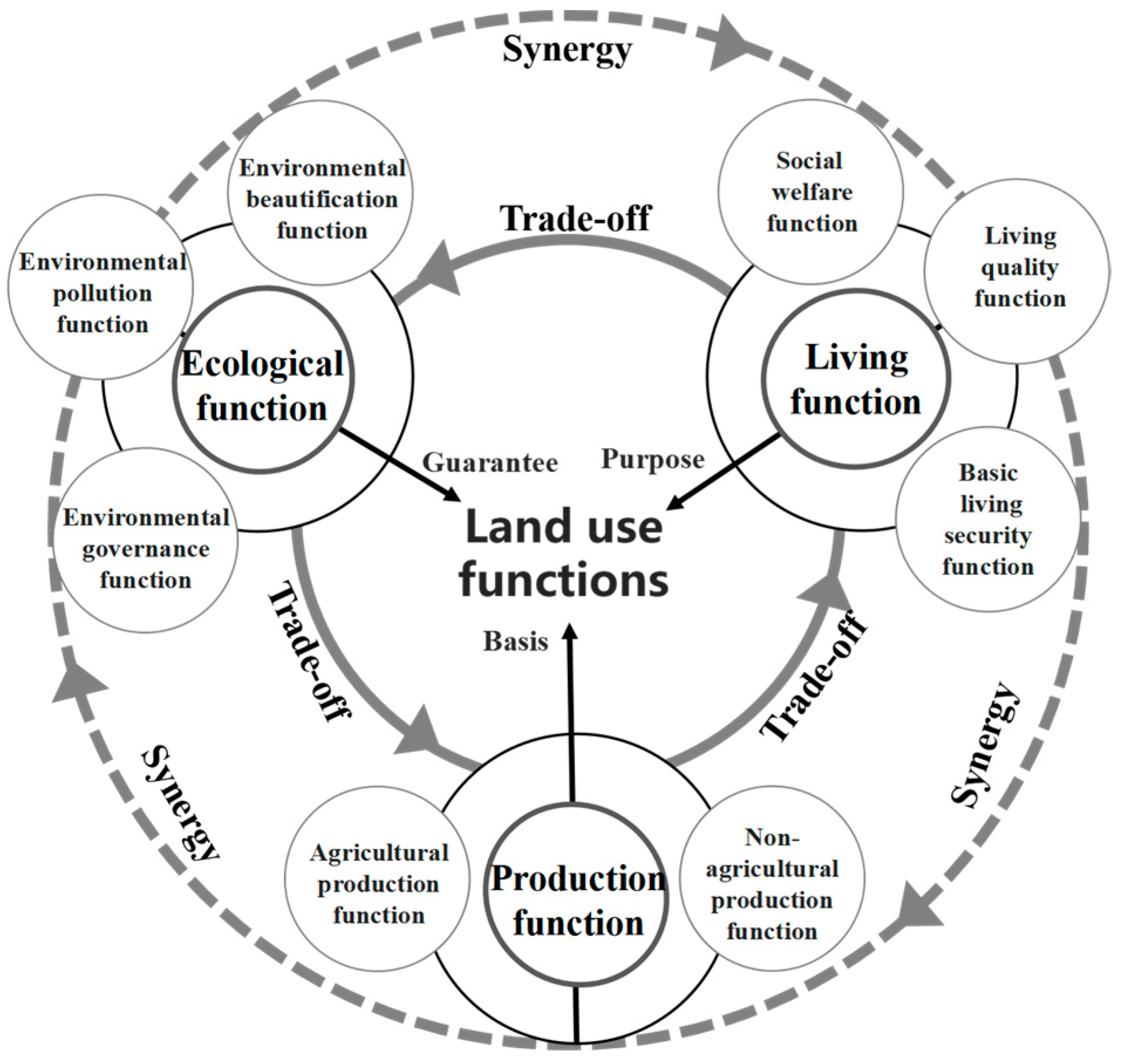



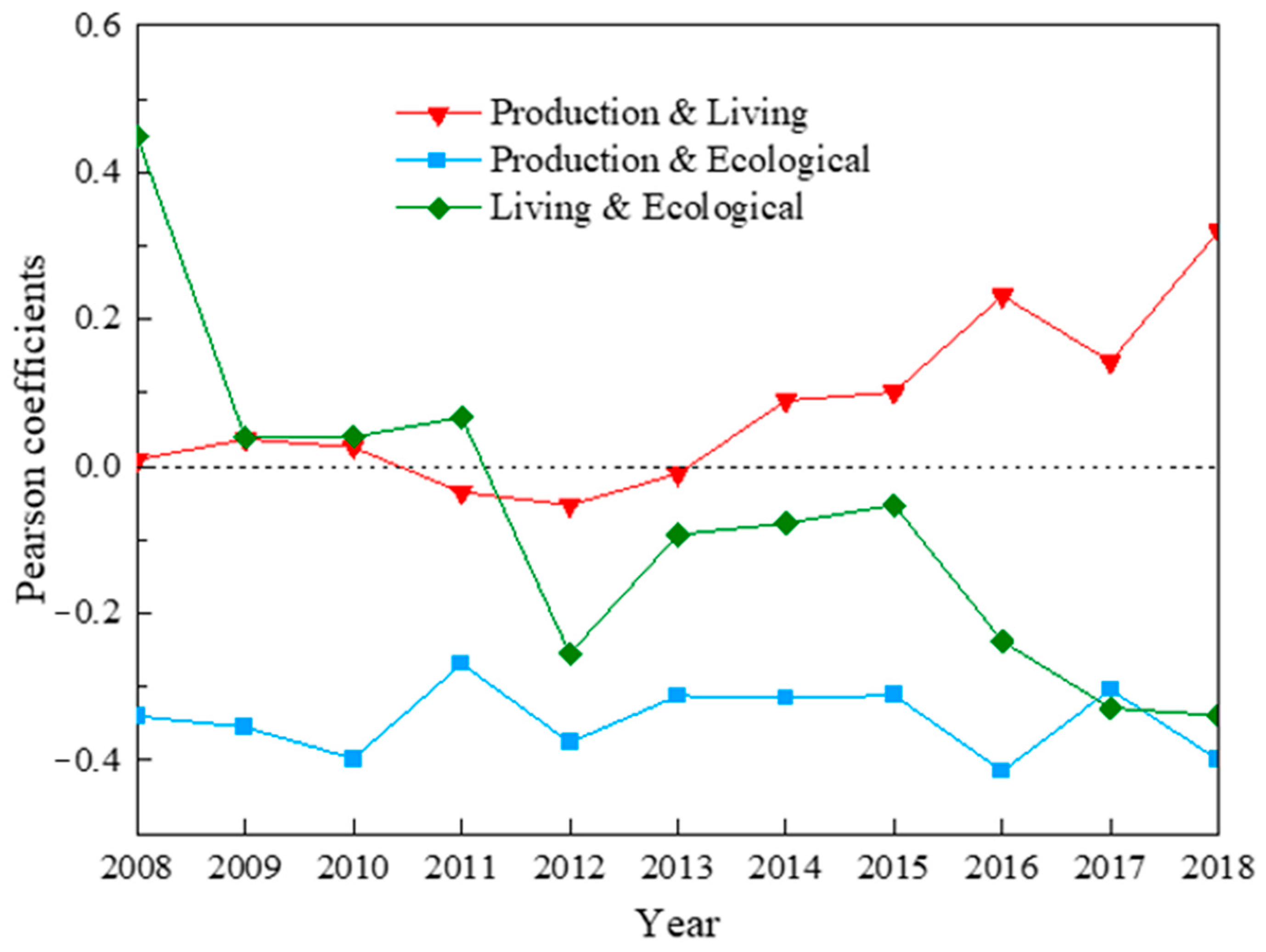
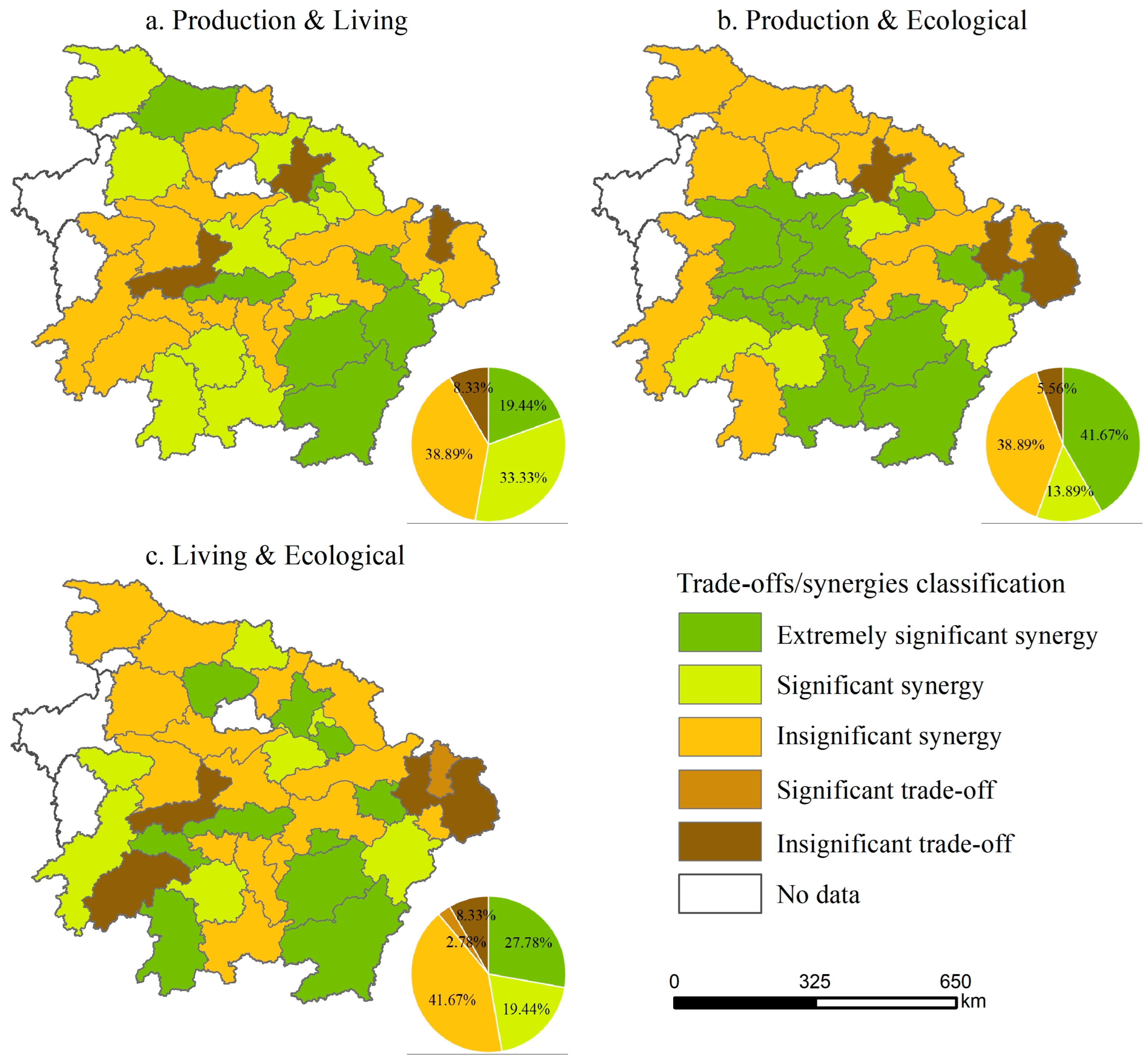

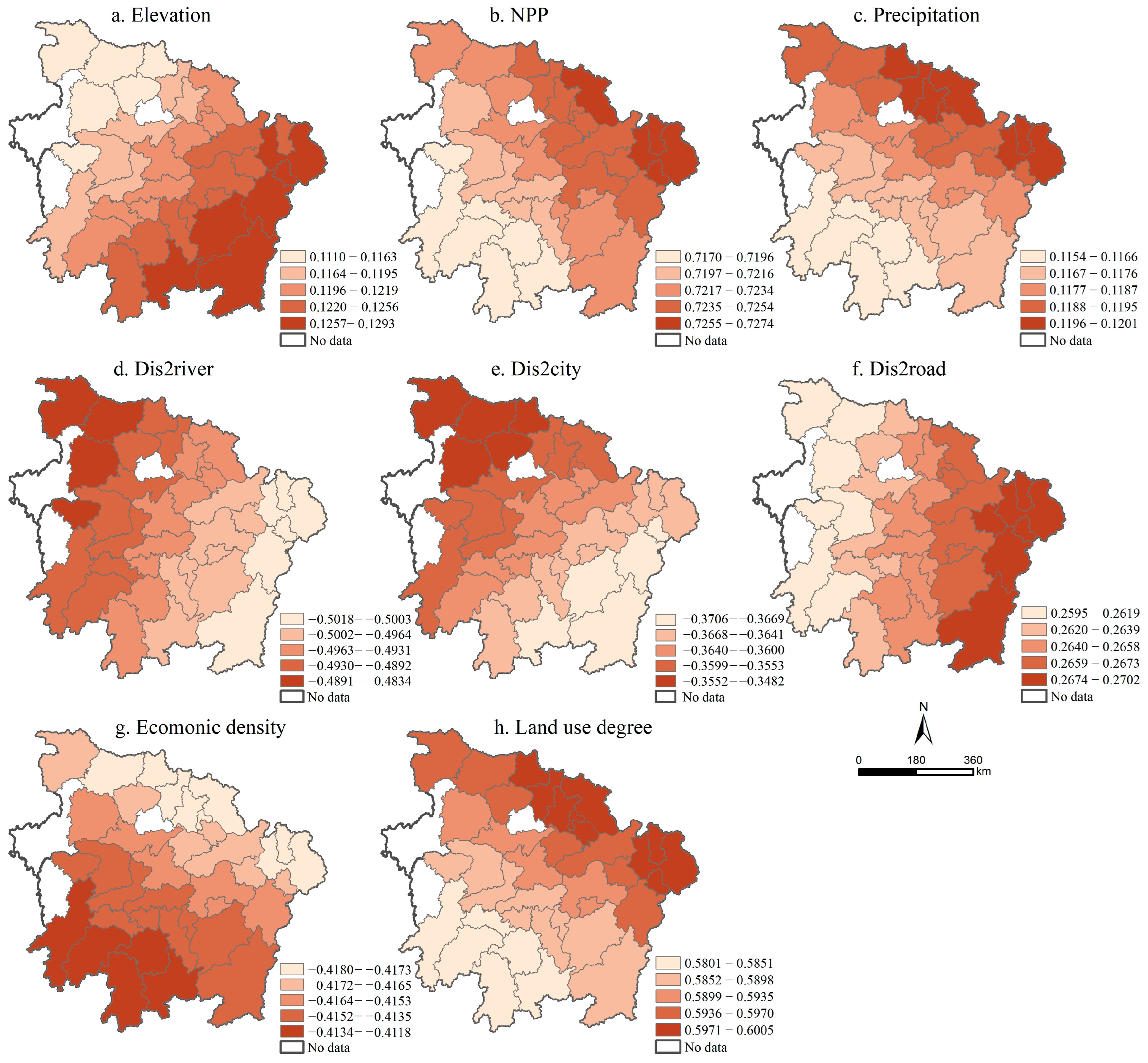
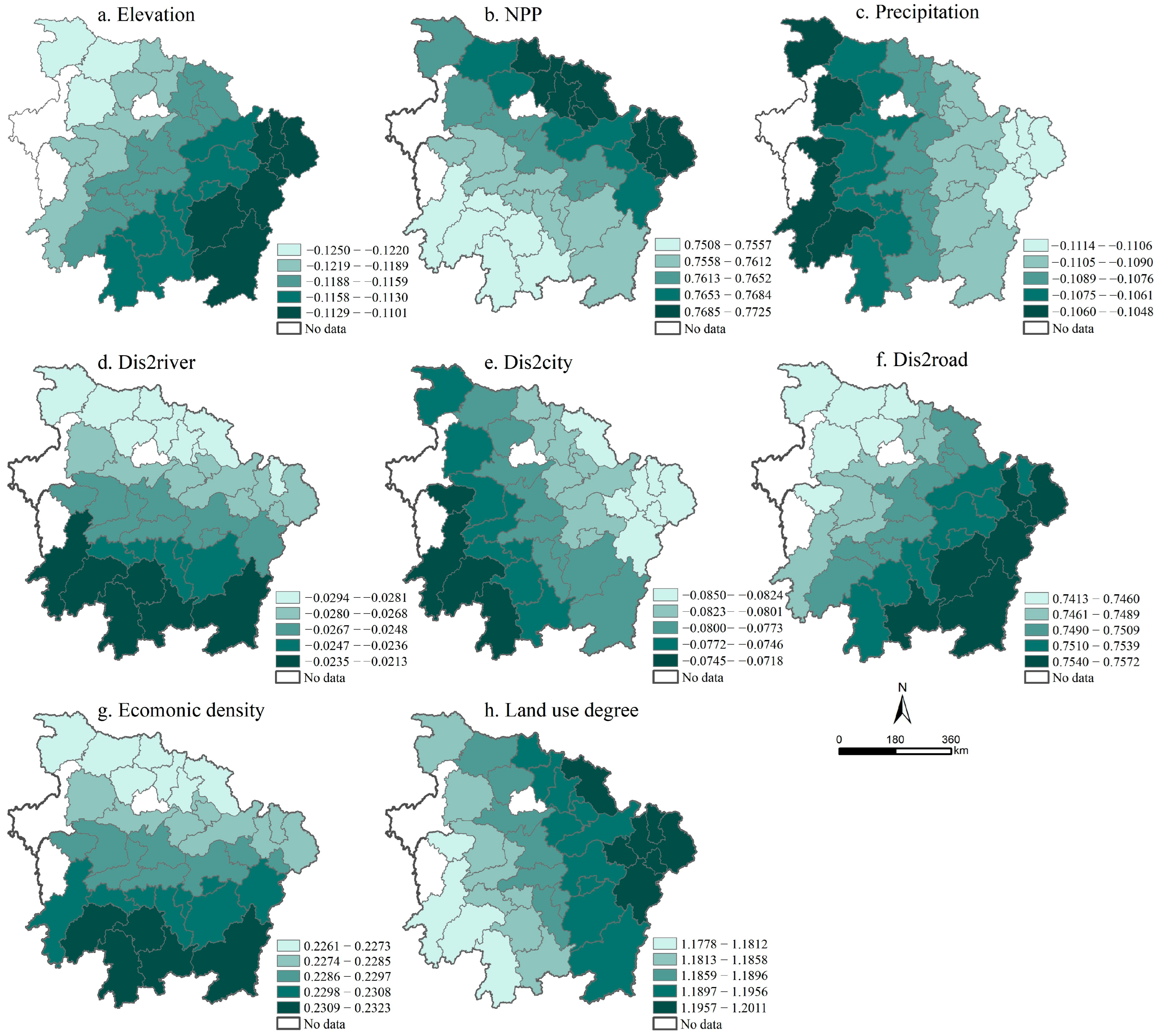
| Functions | Sub-Functions | Indicator | Unit | Weight | Reference |
|---|---|---|---|---|---|
| Production function | Agricultural production function (P1) | Proportion of cultivated land (P11) | % | 0.049 | [39] |
| Total output values of agriculture, forestry, animal husbandry, and fishery (P12) | 108 CNY | 0.048 | [22] | ||
| Non- agricultural production function (P2) | Real estate development investment (P21) | 108 CNY | 0.053 | [17] | |
| The proportion of the added value of the tertiary industry in GDP (P22) | % | 0.051 | [39] | ||
| Number of employees in the tertiary industry (P23) | \ | 0.045 | [22] | ||
| Water used for production and operations (P24) | m3 | 0.053 | [16] | ||
| Per capita GDP (P25) | CNY/ person | 0.048 | [4] | ||
| Living function | Basic living security function (L1) | Per capita daily domestic water consumption (L11) | L | 0.052 | [17] |
| Proportion of construction land (L12) | % | 0.045 | [17] | ||
| Total retail sales of consumer goods (L13) | 108 CNY | 0.041 | [16] | ||
| Social welfare function (L2) | Education expenditure/government expenditure (L21) | % | 0.052 | ||
| Number of hospitals and health institutions (L22) | \ | 0.047 | [22] | ||
| Living quality function (L3) | Population density (L31) | person/ km2 | 0.053 | [39] | |
| Harmless disposal rate of household garbage (L32) | % | 0.052 | [4] | ||
| Ecological function | Environmental pollution function (E1) | Industrial wastewater discharge (E11) | 104 t | 0.052 | [17] |
| Industrial sulfur dioxide emissions (E12) | t | 0.053 | [4] | ||
| Environmental governance function (E2) | Comprehensive utilization rate of industrial solid waste (E21) | % | 0.052 | [4] | |
| Centralized treatment rate of sewage treatment plant (E22) | % | 0.052 | [4] | ||
| Environmental beautification function (E3) | Greenery coverage in built-up areas (E31) | % | 0.052 | [4] | |
| Per capita park green space (E32) | m2/ person | 0.051 | [4] |
| Types | Classification Criteria | ||
|---|---|---|---|
| Positive/Negative Coefficients | Significance | ||
| Synergies | Extremely significant synergy | + | p ≤ 0.01 |
| Significant synergy | + | 0.01 < p ≤ 0.05 | |
| Insignificant synergy | + | p > 0.05 | |
| Trade-offs | Extremely significant trade-off | − | p ≤ 0.01 |
| Significant trade-off | − | 0.01 < p ≤ 0.05 | |
| Insignificant trade-off | − | p > 0.05 | |
| Factors Type | Indicator | Description | Calculation | Reference |
|---|---|---|---|---|
| Natural | Elevation (X1) | Elevation (m) | Extract from DEM | [42] |
| NPP (X2) | Net primary productivity | ArcGIS raster statistics | [42] | |
| Precipitation (X3) | Annual mean precipitation (mm) | ArcGIS raster statistics | [43] | |
| Dis2river (X4) | Distance to river (m) | ArcGIS raster statistics and Euclidean distance | [43] | |
| Socio-economic | Dis2city (X5) | Distance to the provincial capital city (m) | ArcGIS raster statistics and Euclidean distance | [30] |
| Dis2road (X6) | Distance to road (m) | ArcGIS raster statistics and Euclidean distance | [30] | |
| ED (X7) | Economic density (104 CNY/km2) | GDP/total land area | [41] | |
| LUD (X8) | Land use degree (\) | L is the land use degree, Ai is the grade index of the i-th land use type, and Ci is the percentage of the i-th land use type in the total area | [43] |
Disclaimer/Publisher’s Note: The statements, opinions and data contained in all publications are solely those of the individual author(s) and contributor(s) and not of MDPI and/or the editor(s). MDPI and/or the editor(s) disclaim responsibility for any injury to people or property resulting from any ideas, methods, instructions or products referred to in the content. |
© 2024 by the authors. Licensee MDPI, Basel, Switzerland. This article is an open access article distributed under the terms and conditions of the Creative Commons Attribution (CC BY) license (https://creativecommons.org/licenses/by/4.0/).
Share and Cite
Zheng, L.; Wang, Y.; Yang, H.; Bi, Y.; Xu, L.; Wang, Y. Identifying Trade-Offs and Synergies of Production–Living–Ecological Functions and Their Drivers: The Case of Yangtze River Urban Agglomerations in China. Land 2024, 13, 1322. https://doi.org/10.3390/land13081322
Zheng L, Wang Y, Yang H, Bi Y, Xu L, Wang Y. Identifying Trade-Offs and Synergies of Production–Living–Ecological Functions and Their Drivers: The Case of Yangtze River Urban Agglomerations in China. Land. 2024; 13(8):1322. https://doi.org/10.3390/land13081322
Chicago/Turabian StyleZheng, Liang, Yajing Wang, Hui Yang, Yuzhe Bi, Lei Xu, and Ying Wang. 2024. "Identifying Trade-Offs and Synergies of Production–Living–Ecological Functions and Their Drivers: The Case of Yangtze River Urban Agglomerations in China" Land 13, no. 8: 1322. https://doi.org/10.3390/land13081322






